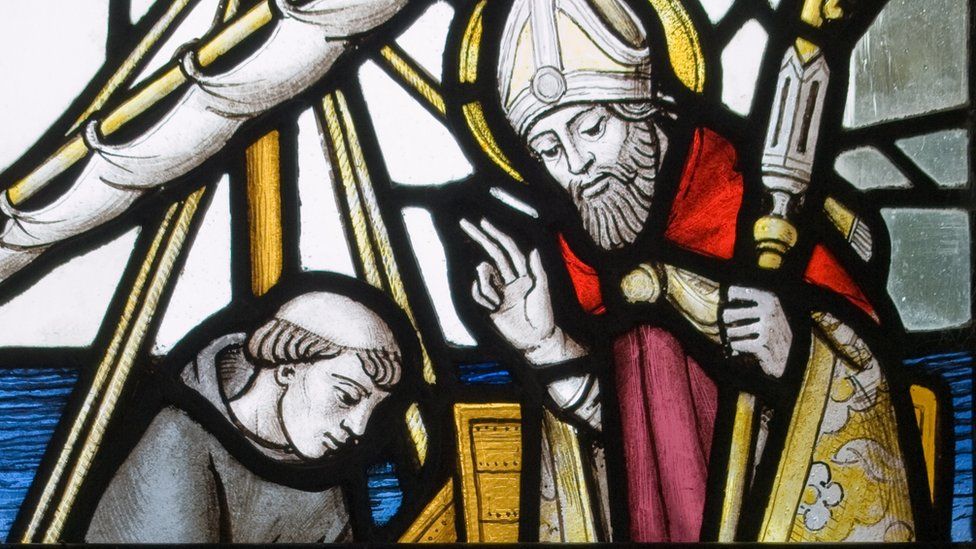St David: Ten things to know about the patron saint of Wales
- Published

Every year on 1 March, Wales celebrates St David's Day - but how much do we actually know about the country's patron saint?
Events across Wales today will celebrate the greatest figure in the Welsh Age of Saints.
He established many religious communities and gives his name to the smallest city in Britain.
But much of what we "know" is based on the Latin writings of Rhygyfarch some 500 years after St David lived.
St David's Day: Who was Wales' patron saint?
Even the image of St David has changed over the centuries.
"Much of the early images are based upon what we see in stained-glass windows where he's portrayed as a very powerful archbishop," said author Martin Crampin.
"But that was never the case at the time of his life.
"It's not until last century that we see him as a hermit, or a more scholarly, humble and down-to-earth figure that perhaps fits in more with what we want to see St David."
So meek or mighty, here are 10 "facts" to ponder.
1) His birthday is a mystery
An angel foretold his birth to St Patrick, 30 years before it happened - although the exact date is believed to be some time between 462 and 515 AD.
Some say he lived more than 100 years and died on 1 March 589 - hence St David's Day.
2) He was born in a storm
Whenever it was, legend says his mother Non gave birth on a cliff-top in Pembrokeshire - during a fierce storm.
At that exact moment, a bolt of lightning from heaven is said to have struck the rock, splitting it in two.
A nearby holy well is said to have healing powers.
3) He had royal heritage
His family was aristocratic. The official biography claims his father was Sant, the Prince of Powys, and his grandfather King Ceredig founded Ceredigion.
Non was a nun and later canonised herself.
4) He's not David
That was the name he was baptised with.
But Non named her son Dewidd, or Dewi to the locals.
5) He took centre stage at Glasto
Educated at a monastery, he became a missionary, spreading Christianity.
Dewi was a renowned preacher, founding monastic settlements and churches in Wales, Brittany and south-west England.
He visited Glastonbury to rededicate the abbey and donated a travelling altar that included a great sapphire - pinched 1,000 years later.
6) He left his mark
Like any seaside tourist, David reputedly brought back a rock - though not the pink boiled sugar kind - from his pilgrimage to Jerusalem.
That stone now sits in an altar at St David's Cathedral, built on the site of his original monastery.
7) He was a teetotal vegetarian
Strict dieters today have nothing on St David. He and his monks led a very simple and austere life living off only leeks and water.
They even refused to use oxen to plough their fields, preferring to do it by hand.
8) Miraculous stories
He is said to have cured his tutor of blindness with the sign of the cross and brought a dead boy back to life by splashing the child's face with tears.
It is also said that the ground beneath his feet rose up to form a hill so people at the back of a large crowd in Llanddewi Brefi could hear him speak before a white dove, sent by God, settled on his shoulder.
9) A celebrity of the Middle Ages
He has been the patron saint of Wales since the 12th Century, at a time when there were more than 60 churches in Wales dedicated to him.
His shrine was so important that Pope Callistus II said two pilgrimages to St David's were worth one to the Vatican.
Vikings regularly raided the cathedral while the shrine was stripped of its jewels during the reformation in the 16th Century.
10) His legacy lives on
His last words to his followers came from a sermon he gave on the previous Sunday: 'Be joyful, keep the faith, and do the little things that you have heard and seen me do.'
The phrase 'Gwnewch y pethau bychain' - 'Do the little things' - is still well-known in Wales.
Related Topics
- Published7 July 2019
- Published1 March 2019
- Published1 March 2019
- Published29 February
- Published1 March 2019
- Published22 January 2019